
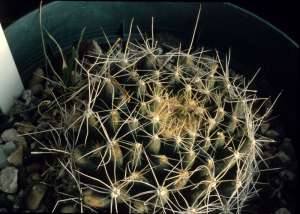
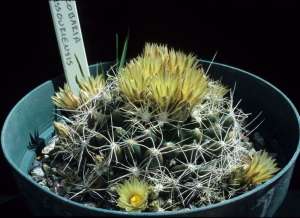
Left: A pot plant of Escobaria missouriensis frozen on the 16th February. Centre: By 1st April the ice has melted and the plant thawed. Right: The plant flowering on the 30th April.
Contents of the Spring 2008 Northants News
|
Letter from America Don Campbell |
I have corresponded with Don who lives in Grand Junction, Colorado for several years. We discuss many things including the weather. It is moist and mild here and dry and hot or cold there. (You know I have generalised a lot here!) January average temperatures there are a minimum of -9ºC and maximum of +3ºC (That’s a bit chilly but the record low is -31ºC. Wow!) Don sends me interesting packets of photo slides and in a batch of pictures of cacti in Antelope Valley Arizona were a set of hardy plants he is cultivating in his garden.
We read that many cacti are hardy and especially those from the high deserts. However I am not sure that Don’s outdoor cultivation methods would apply in middle England - it’s our winter moist and mild. However you can see that low temperatures are not the problem.
 |
 |
 |
|
Left: A pot plant of Escobaria missouriensis frozen on the 16th February. Centre: By 1st April the ice has melted and the plant thawed. Right: The plant flowering on the 30th April. |
||
Incidentally, Don kindly sent me seedlings of Escobaria missouriensis and Sclerocactus glaucus. Both grow very locally to his home. Sadly the Sclerocactus lasted only weeks but the Escobaria has thrived and flowers every year.
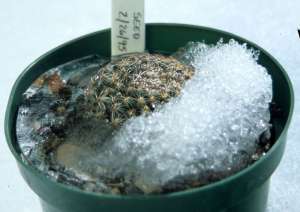 |
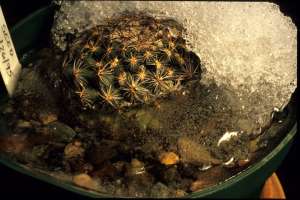 |
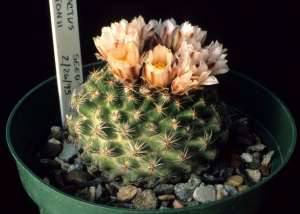 |
| Left & Centre: A frozen Pediocactus knowltonii on the 16th February. The plant was brought in next day. Right: The plant flowering on the 1st April. | ||
Greetings,
Recently, while struggling with a severe case of the December blahs, I visited my little Mexican buddy, Hernandez. He reminded me of the many joys of growing C&S plants Indoors, especially in the winter. My day was instantly brightened and the December doldrums disappeared.
Don
|
|
Don’s buddy Hernandez, aka Mammillaria hernandezii. (This grows in his conservatory. I don’t think the growing method shown above would work.) You can click for a better image. |
|
Three newish books Trevor Wray |
Three new books (well sort of three – you’ll see) have arrived Chez Wray. I don’t suppose they will be making the branch library so I thought I might comment on them.
Cacti of the Trans-Pecos by Michael Powell and James Weedin is a book I wanted as soon as it was published in 2004. For those who fell asleep in the Geography class, this is the area to the far west of Texas and includes the Big Bend and Guadalupe Mountain National Parks and the Franklin and Davis Mountains State Parks. This is an area I visited in 1990 and I would like to return to in the foreseeable future. The area has a varied selection of cacti and over a hundred are described in this book. It was far too expensive to justify purchasing at first but an encounter on the internet brought it to my door for just over £20, including airmail from the US! And it’s a heavy book!
It is also ‘heavy’ in a technical sense with over 500 pages of small print which deals in detail with the taxonomy (naming) and botany of each species. Also Phenology which was a new ‘ology’ to me and deals with seasonal occurrences and in this case flowering and seed maturity. I will find this a useful reference in identifying plants from this area. The only disappointment is perhaps the pictures which are small and at the back. I thought perhaps there weren’t any at first! Still a snip for 20 quid.
Keith Larkin emailed that he had some copies of the second edition of Andriana Hoffman and Helmut Walter’s Cactaceas en la flora silvestre de Chile. It shows how sad I am that I added this to my first edition. First thing to note in the latest edition is that the Neoporterias all have the ‘new’ Kattermann names as Eriosyce. When the regional floras start to accept these changes it is a sure sign that the rest of us old fogies should follow. The book is a very useful treatise on the cacti of Chile but unfortunately it is in Spanish. Luckily the Ed’s computer can speak Spanish quite well enough to make sense of the text. The Ed is working on his Spanish.
The Third book is ‘The Flora of North America’, a massive multi-volume work (at least 26 volumes) and it is the publication of Volume 4 ‘Magnoliophyta: Caryophyllidae, part 1’ which specially interests us. I just know that everyone in the branch is aware that this is the volume that deals with the cacti. However Volume 4 costs $95 (about 50 quid) and includes eight other families which I have never heard of and the Aizoaceae (mesembs) which are invasive weeds of the US. (But mostly very nice in South Africa.) I could never justify the cost but the pages of the book can be consulted with some trouble on Amazon (though not printed).
That was how it stood until I realised that the book (or at least the cactus bits) was available in digital form on the internet. This is a ‘sorta book’, a virtual reality volume. It takes up zero space on the bookshelves (the FL is pleased) and can be consulted with a click and accessed in seconds. (Middle England retains all the old names for cacti but surely everyone has broadband internet connection). OK, so maybe you do not have broadband, but the internet version of the book has all the keys and descriptions found in the paper edition. The classification follows the modern trend of ‘lumping’ and uses the latest genetic research as an aid to evaluate species and genera. It will simplify the naming of US cacti. There is nothing there that will cause difficulty for the amateur British grower, though I did notice that the plant we have become accustomed to calling Escobaria vivipera (hugely distributed in the US in multiple varieties) is listed under Coryphantha. It is probably just a question of remembering that when speaking to the Americans. It is just the same as ‘boot’, ‘pants’ and ‘do not pass’ have a different meaning there.
So there you have two and a bit (I mean byte) books for your bookshelf. Have a glance at the last at least. Follow the links for Flora of North America and then cacti. There is lots that interested me from the primary link.
Trev